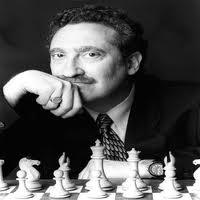
Pandolfini's Puzzler #25 - Looking and Rooking
Professor: Today I’d like to begin at the end – that is, with a rook ending.
Lucian: You mean an ending where both sides have a rook on the board? In that case, I expect there are some pawns on the board, too.
Zephyr: Or maybe you mean an ending with two rooks for each side? Add some pawns, and those endings can be very dangerous.
Professor: Chess itself can be very dangerous, especially for the unwary. But the position I’m thinking about doesn’t fall into either of those classes.
Lucian: What class does it fall into?
Professor: I’m thinking of the category king and rook vs. king and pawn.
Zephyr: Some of those positions can be tricky.
Professor: To be sure! But let’s get concrete. Please consider the following situation.
Professor: First of all, it’s White to move. White’s rook is attacked by Black’s king. Obviously, White can draw at any time by sacrificing the rook for Black’s passed pawn. But White wants more.
Question: How can White move and win?
Zephyr: I suppose we have to figure out what square the rook must move to that works best.
Lucian: Well, it could move across the rank. Maybe it could get far enough away to annoy Black’s king without being in danger from Black’s king.

Zephyr: That might work, moving the rook along the rank, but I’m not sure we can stop the pawn, not without having to sacrifice the rook.
Professor: So what do you want to analyze first, 1. Rh4 or 1. Ra4?
Lucian: I think we should kind of eliminate 1. Ra4.
Professor: Why do you feel that 1. Rh4 might be better than 1. Ra4?
Zephyr: I don’t think we should spend so much time analyzing 1. Ra4. The reason is that, with White’s rook over on the queenside, it’s easier for Black’s king to use the pawn for shelter against rook checks.
Professor: Okay, let’s assume your reasoning is good. What’s a likely line after 1. Rh4?
Lucian: I think a possible line then would be 1…d4 2. Kd7 d3 3. Kc6 d2 4. Rh1 Ke4 5. Kc5 Ke3 6. Kc4 Ke2, and White will have to sac his rook to stop the pawn.
Professor: Your analysis, Lucian, seems good. Of course, there are other variations you haven’t mentioned. They’re worth examining, too, but they also don’t help White get more than a draw. For homework, please confirm this by analyzing them on your own.
Zephyr: I have a feeling the right answer has to do with staying on the d-file.
Lucian: If that’s true, I think we can rule out 1. Rd3, since Black’s king will gain a tempo by attacking the rook.
Zephyr: Does that mean we’re down to considering either 1. Rd1 or 1. Rd2?
Professor: I wouldn't rule out 1. Rd3. But let’s compare retreating the rook to d1 or d2.
Lucian: You always remind us, Professor, that a rook is a long-range piece.
Zephyr: True, you’re constantly saying that a rook works best from far away.
Lucian: If that’s true, I guess the move should be 1. Rd1.
Professor: Unless the initial distance is not the key factor. But think it over. You tell me what else comes into play, and please support your answer with specific variations.
So which is the better first move? Should White play 1. Rd1 or 1. Rd2? Also, explain your thinking.
Answer below - Try to solve Professor Pando's puzzle first!
ANSWER #25
The correct move is 1. Rd2! (or 1. Rd3!).
We can see why 1. Rd2 and 1. Rd3 are better retreats if we first consider 1. Rd1?.
After 1. Rd1?, Black is likely to play 1…d4, taking the opposition. If 2. Kd7, Black maintains the opposition with 2…Kd5. There are various tries from here; none of them now win.
If White tries 3. Rd2, to gain back the opposition between the kings, Black can hold by advancing his king and soon gaining time on the rook.
For instance, after 3. Rd2, play might go 3…Ke4 4. Kc6 Ke3, gaining an important tempo.
White now has to waste a move to save his rook, instead of using that move to bring his king closer. The position is now drawn after 5. Rd1 d3 6. Kc5 d2 (6...Ke2 also works) 7. Kc4 Ke2. By next move, the rook must surrender itself for the pawn.
Or, after 3. Rd2, play could also go 3…Kc4 4. Ke6 Kc3 5. Rd1 d3 6. Ke5 d2 (or 6...Kc2) 7. Ke4 Kc2, and that’s also a draw.
However, after the correct rook retreats, 1. Rd2! or 1.Rd3!, White can avoid losing a tempo later on.
Play might then go 1…d4 2. Rd1 (whether the rook is coming from d2 or d3) , and Black loses.
With the rook now farther away from Black’s king, a tempo will not have to be sacrificed, and White’s king can get back in time to stop the pawn.
Take note
Rooks tend to be more useful the farther away they are from their targets. They’re also usually safer being farther away, since the enemy king can't attack them when so distanced. That means a distant rook can deliver attacks without harassment from the enemy king's approach. If a rook can operate effectively and securely – that is, if it’s far enough away from the enemy king – we say the rook has “the checking distance.” That distance, if we’re going to assign a number to it, is typically four squares from the rook to enemy king (or three open squares in between).
RELATED STUDY MATERIAL
- Just in case you've never learned the king and rook checkmate, here's everything you need to know;
- Here's tons of examples of rooks performing another common mate on the back rank;
- Or, double your pleasure, and your devastation, with two rooks on the back rank;
- If you have a true rook-and-pawn endgame, here's the best video you could ever watch;
- Let's give the pawns some credit - every once in a while they get the best of the rook!






